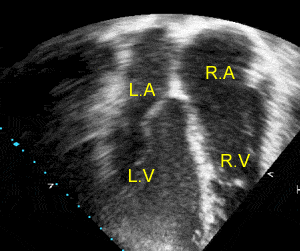The heart is a muscle that pumps blood around the body. It starts beating while we are still in our mother's womb and does not stop until we die. When we are stressed the heart can beat at 200 beats per minute. At rest, a healthy athlete's heart beats at around 60 beats per minute.
Click to see the blood flow inside the heart.

It pumps, about, 5 litres of blood every minute and beats about 100,000 times a day or 35 million beats a year. That is some workrate and if the heart was made of normal skeletal muscle it would become fatiqued and unable to function with devastating consequences. Thankfully, the heart is made of a special type of muscle, called cardiac muscle.
The heart is a complex organ designed to be an efficient pump. It has
4 chambers the :
Right atrium(R.A);
Right ventricle(R.V);
Left atrium(L.A);
Left ventricle(L.V).
(Identify these chambers by scanning the image above with the cursor)
An ultra sound image of the working heart is shown on the right with the four chambers labelled. The little flaps that move up and down are valve cusps. These will become obvious when you perform your heart dissection.
Click for a more comprehensive picture of the
heart.

The right atrium pumps blood into the right ventricle. The right ventricle pumps blood through the pulmonary artery to the lungs. There, the blood becomes oxygenated and carbon dioxide is removed. The blood is returned via the pulmonary vein to the left atrium. The left atrium squeezes blood into the left ventricle. When the left ventricle contracts it pumps blood, at high pressure, into the aorta where it is transported around the body. Valves in the heart keep the blood going in one direction..
The left ventricle is thicker than the right ventricle. The reason for this is that the left ventricle has to pump blood around the body while the right pumps blood to the lungs which are close by.